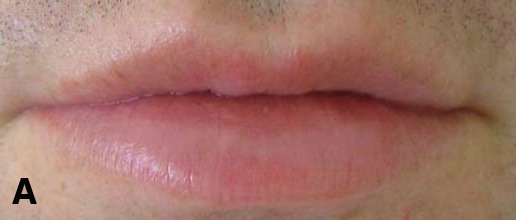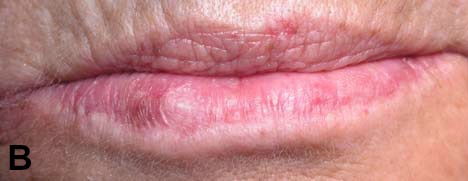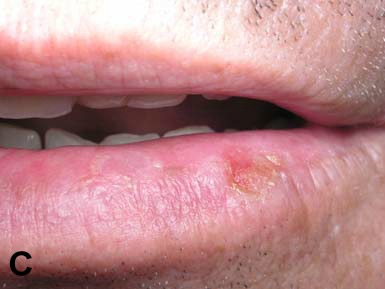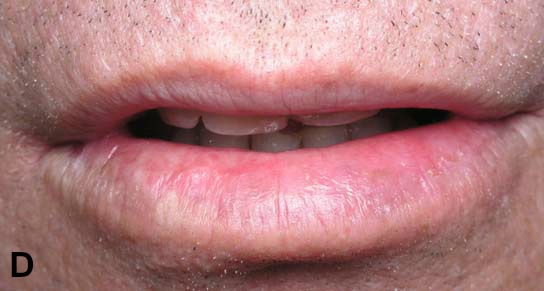Solar CheilitisWhat is the cause? Solar cheilitis (also known as actinic cheilitis or cheilosis) is a degenerative condition of the tissue of the lips after years of exposure to ultraviolet (UV, mainly UVB) light, such as sunlight. It is a premalignant condition. Who is most at risk? Solar cheilitis is more common in adults and the risk increases with age. Men are affected more commonly than women. Individuals with fair skin (less protected from the sunlight) have a higher rate of solar changes. Outdoor workers who do not use sun protection are particularly at risk.
What does it look like? Solar cheilitis predominantly affects the lower lip because it tends to be more prominent. The homogenous pink color of the healthy lip (Figure A) is replaced with non-homogenous white/gray, pink, red, or brown areas and the normally sharp vermillion/skin border becomes less distinct (Figure B). In more advanced stages, the lip may appear cracked or show ulcerations (ie sores) or crusting. Firmness or a non-healing ulcer within these changes may indicate an early cancer (Figure C & D below).
Figure C: Carcinoma of the lip as an ulcerated area (arrow) in a 50 year-old male with a fair skin. Is there a risk for lip cancer? Chronic exposure to the UV light can cause mutations (damage in the DNA) in the cells that make up the skin covering the lip. Over time this may lead to precancerous changes and eventually, in some cases, a cancer known as a squamous cell carcinoma. How is this diagnosed? A biopsy of the suspicious area followed by microscopic examination is often recommended. Is there a treatment? The tissue damage in solar cheilitis is irreversible. Sun protection at any stage can only prevent further damage. If your doctor recommends removal, smaller premalignant lesions can be easily removed with minimal surgery. In more widespread lesions, an operation referred to as a “lip shave” may be performed in which the covering of the lip is removed. Squamous cell carcinoma of the lip has a good prognosis if diagnosed in the early stages. All patients with a history of premalignant lip lesions or squamous cell carcinoma require periodic follow-up to monitor for additional changes or recurrences. QUESTIONS AND ANSWERS ABOUT SOLAR CHEILITIS Q: My father had solar cheilitis and a lip carcinoma; is it inherited? Q: Can solar cheilitis be avoided? Q: How can I prevent the development of any actinic-related diseases in my children? Q: Is indoor tanning in salons dangerous? Q: Can I use lipstick if I have been diagnosed with solar cheilitis or dysplasia? Q: Are the lip changes related to skin lesions? Recommended Links: Prepared by R Czerninski, D Lederman, H Ephros, and R Kerr The information contained in this monograph is for educational purposes only. This information is not a substitute for professional medical advice, diagnosis, or treatment. If you have or suspect you may have a health concern, consult your professional health care provider. Reliance on any information provided in this monograph is solely at your own risk. |




